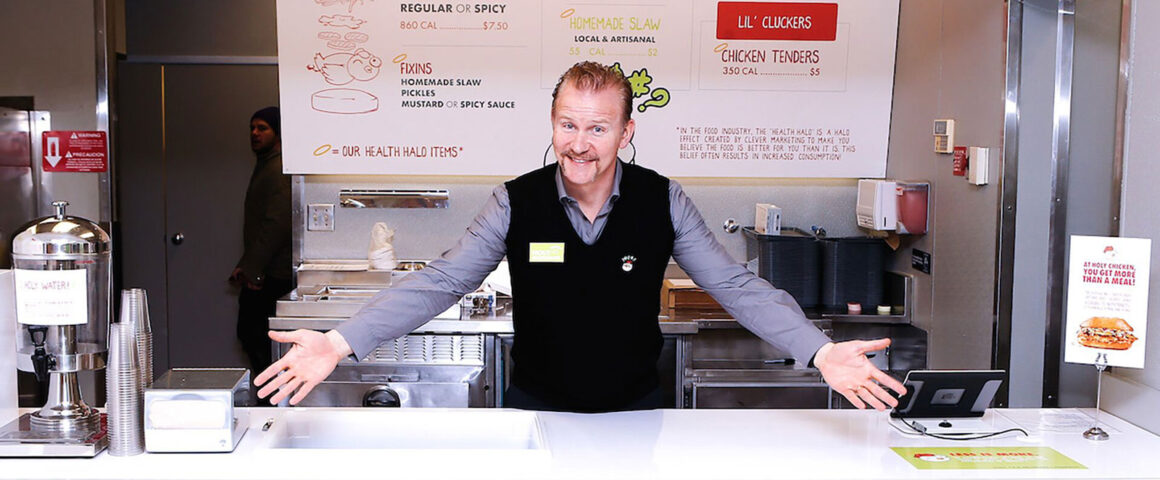Who fancies a chicken sandwich? Would you like it grilled? Fried? Crispy? Imagine that fresh-looking white meat, that crunchy coating, the mayonnaise and lettuce, the bun that is just moist enough without being soggy. Delicious, right? Healthier than a McDonald’s burger, surely? After viewing Super Size Me 2: Holy Chicken!, the latest film from Morgan Spurlock, you may want to rethink that.
After gaining fame (and weight) for his 2004 documentary “Super Size Me,” where he showed the dangers of intense McDonald’s consumption, Spurlock now investigates the mechanics of restaurant management. A more conventional documentary maker would interview managers, staff and customers, but we expect more from Morgan. And more is what he delivers, as our presenter and director takes on the challenge of setting up a fast food restaurant. No, you read that right — he’s setting up a fast food restaurant. Spurlock’s justification is that the only way to know is to do, and do he does, renting barn space, raising chickens, converting a disused former Wendy’s into his new Holy Chicken! establishment, and along the way learns and — most importantly — shares a host of information about the foulness of dealing with fowl.
The gimmick of starting his own restaurant is an effective hook, largely trading on Spurlock’s charisma. He is a charming and engaging host, whether dealing with companies over the phone, established chicken farmers and potential staff for his restaurant, and indeed with the chickens. His scenes with the birds are particularly delightful, and highlight the lack of empathy associated with the consumption of meat. This highlighting is achieved through animations that show the passage of chickens through the industrial process, that are both amusing and terrifying all at once. Watching these sequence might prompt a viewer to consider vegetarianism, but even if not provides food (pun unintended, honest!) for thought.
The industrial process and indeed empire is the true target of the documentary. Spurlock’s attempts to contact large scale companies often encounter silence and bureaucratic runaround, best encapsulated when he calls a company, gives his name and is asked if he is Morgan Spurlock, the documentary filmmaker. Upon giving confirmation, the call is terminated. Undeterred, Spurlock digs deeper, revealing further information. Much of the material about food advertising and the regulations and requirements of the US Food and Drug Administration is disquieting but perhaps not surprising to any cynic. What appear to be assurances are rubber stamps, due to lack of government funding and therefore staffing. But a key ingredient in the continuation of such dissembling is the public willingness to accept simple labels that turn out to be little more than platitudes. Public acceptance of questionable practices are key to allowing the continuation of such practices, and Spurlock and his team are careful not to judge, only reveal. Over the course of Super Size Me 2: Holy Chicken!, the truth behind “free range,” “organic,” “grilled” and other such terms are revealed, to unsettling effect that prompts an almost literal naked lunch moment. What exactly is on your plate and what do those labels mean? And how much harder would daily shopping and consumption be if we investigated the regular fare on offer?
Beyond the labeling and legalities, the surprising and in some cases quite appalling revelations concern the chicken industry of the US. Referred to as Big Chicken (creating a parallel with that other beloved corporate amalgam, Big Tobacco), the chicken industry is presented by the film as a merciless monopoly, the malevolent villain of the piece, seemingly as exploitative and downright ruthless as medical insurance (see Michael Moore’s “Sicko”), entertainment or politics, or for that matter, organized crime. Animal welfare may not be a corporate concern or even one for the viewer, but the scenes that depict the suffering of chicken farmers, held in what is effectively indentured servitude to their Big Chicken masters, are moving and angering. It is this aspect of Spurlock’s investigation that makes Super Size Me 2: Holy Chicken! a scathing exposé, but, once again, Spurlock never displays outrage or fury. Rather, he lets the material speak for itself, and the consumer is left to decide. Pierre Takal’s editing neatly interweaves the personal journey of Spurlock and the viewer’s disturbing journey into Big Chicken, ensuring that our understanding is closely tied to our own experiences as consumers.
The film’s respect for the consumer is consistent, as when Spurlock’s restaurant opens, its unique selling point is honesty. Spurlock and his staff follow the same regulations as other fast food establishments, but use transparency rather than spin. The response of the customers is striking and the viewer might well feel like visiting Holy Chicken! themselves, despite the warnings they have received. After all, are you likely to start growing your own food? But the film’s biggest surprise comes in the end credits, which caused this reviewer’s jaw to drop. Just that is worth the viewing, but there is plenty of fascinating material beforehand.



